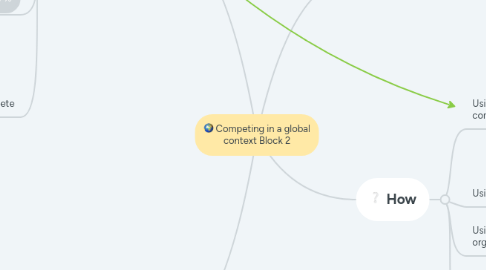
1. Importance
1.1. Guiding effective decision making (session 1)
1.2. Key for Organisations success (session 1)
1.3. Understanding operations broader environment (session 1)
2. How
2.1. Using theories and models to help compete ( session 2)
2.1.1. Diamond model (Porter 1990)
2.1.2. Five forces model (Porter 1980)
2.1.3. Competitive advantage
2.1.4. Comparative advantage
2.2. Using the PESTLE analysis (session 1 and 9)
2.2.1. Political, economic, social, technological, legal and environmental.
2.3. Using information from the world trade organisation
2.4. Adopting convergence or divergence (session 9)
2.4.1. Convergence- to adopt similar values
2.4.2. Divergence - to mirror assumptions
2.4.3. Using the PESTLE tool will help here
3. Financial
3.1. understanding Comparative position
3.2. Financial reporting (session 5)
3.2.1. Reporting standards designed by IFRS
3.2.2. Company accounts are understandable and comparable
3.2.3. Types of reporting
3.2.3.1. Stewardship
3.2.3.2. Savary Ordonnance
3.2.3.3. capital market function
3.3. Tax and exchange rates (session 6-7) %
3.3.1. to understand cross boarder tax rules
3.3.2. Tax evasion is illegal
3.3.3. Exchange rate is the price of one currency in terms of another
3.3.4. If high rate then a strong currency, if a low rate then a weak currency
3.4. Using financial support to help compete
3.4.1. IMF
3.4.2. The world capital bank
4. Global market place session 13-15
4.1. Using the marketing process
4.1.1. Formulating the offering
4.1.2. choosing a marketing strategy
4.1.3. monitoring and evaluate
4.1.4. pursuing the organisations mission, vision and values
4.2. A global firm is one that is operating in more than one country
4.3. Macro and Micro environment
4.4. Seven triggers to prompt expansion
4.4.1. Saturated domestic markets
4.4.2. Small domestic markets
4.4.3. Customer drivers
4.4.4. Competitive forces
4.4.5. Cost factors
4.4.6. Portfolio balance

